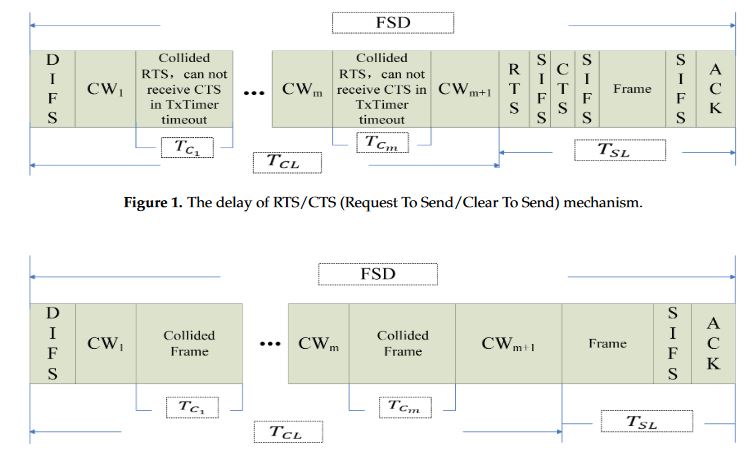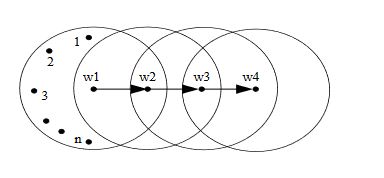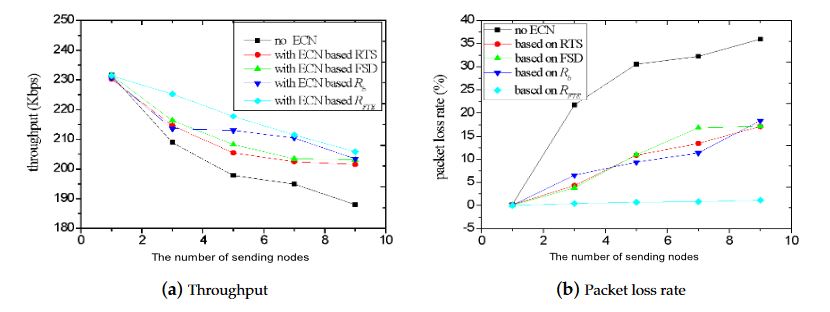ABSTRACT
Different from the traditional wired network, the fundamental cause of transmission congestion in wireless ad hoc networks is medium contention. How to utilize the congestion state from the MAC (Media Access Control) layer to adjust the transmission rate is core work for transport protocol design. However, recent works have shown that the existing cross-layer congestion detection solutions are too complex to be deployed or not able to characterize the congestion accurately.
We first propose a new congestion metric called frame transmission efficiency (i.e., the ratio of successful transmission delay to the frame service delay), which describes the medium contention in a fast and accurate manner. We further present the design and implementation of RECN (ECN and the ratio of successful transmission delay to the frame service delay in the MAC layer, namely, the frame transmission efficiency), a general supporting scheme that adjusts the transport sending rate through a standard ECN (Explicit Congestion Notification) signaling method.
Our method can be deployed on commodity switches with small firmware updates, while making no modification on end hosts. We integrate RECN transparently (i.e., without modification) with TCP on NS2 simulation. The experimental results show that RECN remarkably improves network good put across multiple concurrent TCP flows.
WIRELESS CHANNEL CONGESTION DETECTION
How to detect wireless channel congestion is important for congestion control design in wireless networks. Recent works have proposed several congestion metrics at the MAC layer.
(1) Retransmission counter: There exists a correlation between the number of RTS (Request to Send) retransmissions and channel congestion extent at the MAC layer. In when the number of RTS retransmissions is greater than two, the wireless channel will be deemed as congested, and the TCP sender will decrease its sending rate. Though this method is very easy to deploy, the number of RTS retransmissions is not able to describe the congestion state accurately.
DEFINITION AND THEORY ANALYSIS

Figure 2. The delay of the basic access mechanism
In the DCF (Distributed Coordination Function) mode, each node uses the CSMA/CA (Carrier Sense Multiple Access with Collision Avoidance) mechanism to compete for wireless channel. Firstly, the sender will detect the channel. If the idle time lasts for the DIFS (Distributed Inter-frame Spacing) time interval and a random backoff time, RTS or the data frame will be sent. If no CTS or ACK is received within a specified period, this frame is considered lost. Then, the transmitter will double the size of the contention window and choose a new backoff timer. The model of MAC layer service delay is shown in Figures 1 and 2.
PROTOCOL DESIGN
Specifically, in the RECN scheme, when the value of RFTE is smaller than a given threshold, wireless routers will explicitly mark packets with a CE (Congestion Explicitness) bit in the IP (Internet Protocol) header. By this cross-layer ECN mechanism, the sender will adjust its sending rate on receiving congestion notification. RECN works at the MAC layer and uses the standard ECN mechanism. Thus, in the RECN scheme, there is only very small modification at the MAC layer.
PERFORMANCE EVALUATION

Figure 4. Simulation scenario
In this section, we conduct simulations in NS2.27 (Network Simulator 2.27). The simulation scenario is shown in Figure 4. The transmission range of each node is 250 m, and the sensing range is 550 m. The route protocol is DSDV (Destination-Sequenced Distance-Vector routing protocol). We set the channel bandwidth (channel transmission rate) to 1 Mb and use 1000 bytes as the fixed size of each data packet.

Figure 5. Comparison with other metrics
Figure 5a shows that with the increasing number of sending nodes, the throughput decreases as a whole. However, compared with the no ECN situation, the decline of throughput is not so obvious as using ECN with the MAC layer’s metric. Specifically, the more sending nodes, the more obvious the improvement of the throughput is. This is because with more sending nodes, the possibility of congestion also increases. The sender using the ECN mechanism will reduce its sending rate when the congestion occurs.
CONCLUSIONS
In wireless multi-hop ad hoc networks, congestion control plays an important role in reliable transmission. If the traditional TCP protocol is used, the network performance will degrade because of the poor interaction between the MAC and TCP layers. This paper proposes an MAC congestion notification scheme based on the frame transmission efficiency, which improves TCP performance with the congestion notification from the MAC layer.
Analysis and simulation results show that our scheme outperforms traditional TCP in terms of throughput and fairness. Specially, it is realized with a small modification at the MAC layer, which can be applied to other existing TCP protocols. Therefore, the ECN mechanism has been widely used in recent years. Thus, our scheme has good adaptability and generalization.
Source: South China University
Authors: Huaguang He | Taoshen Li | Luting Feng | Jin Ye